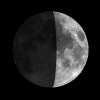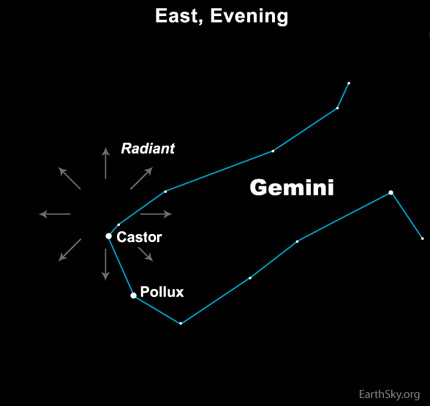Courtesy of EarthSky
A Clear Voice for Science
Visit EarthSky at
www.EarthSky.org

 The best night for viewing the 2010 Geminid meteor shower might be the night of December 13 from late night until dawn (Monday before midnight, Tuesday morning after midnight). You will see the most meteors after the moon sets in the middle of the night.
The best night for viewing the 2010 Geminid meteor shower might be the night of December 13 from late night until dawn (Monday before midnight, Tuesday morning after midnight). You will see the most meteors after the moon sets in the middle of the night.
By the way, the bright “star” near tonight’s moon is the planet Jupiter.
Generally, the shower intensifies after midnight and reaches its peak around 2 a.m. The Geminids often produce 50 or more meteors per hour, or about one per minute.
What is the best way to watch a meteor shower? You need a dark sky far from city lights and a wide-open view of the sky. City, state and national parks are good, and you might be able to camp and make a night of it. Enjoy the comfort of a reclining lawn chair – the warmth of a sleeping bag – a thermos with a hot drink – a snack – and possibly star maps with a red flashlight, if you want them (you won’t need them to enjoy the meteors).
Give your eyes at least 20 minutes time to adapt to the dark. Often, meteors come in spurts and are interspersed by lulls. Give yourself at least an hour to watch the Geminids.
The Geminids rank as one of the best meteor showers for the year in both hemispheres. This year, the waxing gibbous moon will interfere in the evening hours, but the moon will set in the west around midnight, leaving a dark sky for the peak hours of the Geminid shower.
This meteor shower gets its name from the constellation Gemini the Twins. If you trace the paths of all the Geminid meteors backward, they appear to radiate from the same point in front of Gemini. This point is called the meteor shower radiant, and is located near the star Castor. However, you don’t have to find the meteor shower radiant to see the Geminid meteors, for these meteors shoot all over the sky.
Radiant point for December’s Geminid meteor shower
Most meteor showers take place when our planet Earth crosses the orbital path of a comet. The comet debris plunges into Earth’s upper atmosphere and the vaporizing particles fill the night with meteors. However, the Geminid meteor shower appears to be an oddity. The shower’s parent body looks more like an asteroid rather than a comet.
That’s tonight – the moon and the blazing planet Jupiter lighting up the evening hours, and the Geminid meteor shower at its best in the wee hours after midnight.
Written by Bruce McClure
Astronomy Picture of the Day from NASA/JPL
U.S. Naval Observator Astronomical Information center
The York County Astronomical Society
 Print This Post
Print This Post








